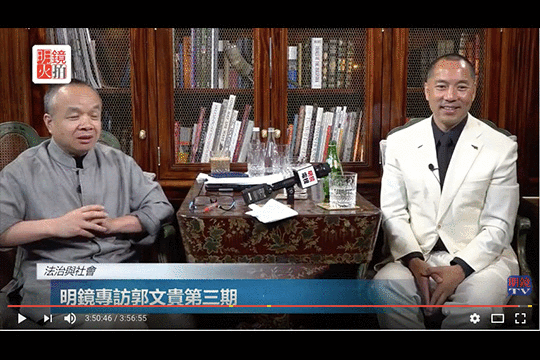The Chinese Donald Trump? – China’s latest top news
Jeremy Goldkorn’s selection of the top stories from China on June 16, 2017. Part of the daily The China Project newsletter, a convenient package of China’s business, political, and cultural news delivered to your inbox for free. Subscribe here.

Who will rid me of this turbulent, tweeting exiled billionaire?
Guo Wengui 郭文贵 — the exiled real estate and financial tycoon who has been in a war of words with parts of the Chinese government, Wang Qishan 王岐山, Hainan Airlines, real estate developer Pan Shiyi 潘石屹, Caixin magazine, and many of his former business partners — loves the limelight.
On the morning of June 16, Mingjing magazine live-streamed (in Chinese) its third interview with him, promising explosive allegations about the government. The live stream went down several times, possibly because it was hacked. We did not have enough time to closely watch the whole three-hour interview before sending this newsletter, but Guo does not seem to have revealed anything substantial that he has not previously mentioned.
He takes the opportunity to throw some mud at the recently detained chairman of Anbang. He attacks his usual enemies. He waves some papers at the camera and says that they prove that some of his various enemies had transferred money for nefarious purposes, but there does not seem to be any substantial evidence. Rather, it seems Guo is perfecting a Donald Trumpish act: Wearing a white suit and referring to himself in the third person, he hints at crimes of which he says he has evidence that he will not yet reveal, and says he is on the side of the people.
Meanwhile, in China, ABC reports that the Dalian Xigang People’s Court announced prison terms and fines for three of Guo’s former employees who “prosecutors said were ordered by Guo to falsify financial documents” to obtain loans from a state bank. Guo’s real estate firm Beijing Pangu Investment Company was also fined $36 million.
A Himalayan land grab or a matter of perception?
“Bite by kilometer-size bite, China is eating away at India’s Himalayan borderlands,” says Brahma Chellaney, professor of strategic studies at the New Delhi–based Center for Policy Research, in an article on Project Syndicate. According to Chellaney, “On average, China launches one stealth incursion into India every 24 hours.” He adds that “India has lost nearly 2,000 square kilometers…over the last decade” to encroachments by China’s People’s Liberation Army (PLA), according to a former “top official with India’s Intelligence Bureau.”
Chellaney argues that China has a similar approach in the Himalayan region as in the South China Sea, using “civilian resources — herders, farmers, and grazers — as the tip of the spear.” Once there is a civilian presence on the contested land, the PLA moves in to establish control without having to fire a shot.
How to stop this encroachment? Chellaney is hawkish: “To halt further encroachments, India will need to bare its own teeth.”
On the other hand, the Hindustan Times reports that Indian army chief Bipin Rawat says recent “counter intrusions take place from both the sides” of the Line of Actual Control, which serves as the border between China and India. He added, “We also fly our helicopters on the space that may be considered intrusion by the other side.” Rawat also apparently emphasized “the need to improve relations with China.”
This year has seen a noticeable increase in tensions between India and China. However, the issue that has been most divisive, judging from public statements from Indian officials, is the still-in-the-making China-Pakistan Economic Corridor, a transport and infrastructure project that cuts right through Gilgit-Baltistan, a region that India claims is part of its territory.
Tiger farms aren’t saving tigers
On China Dialogue, Aron White writes, “An explosion in the number of captive tigers has done nothing to stop the killing of wild tigers. Instead, the tiger farming industry has sustained and stimulated demand for tiger parts.”






